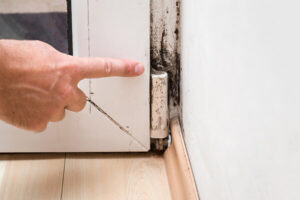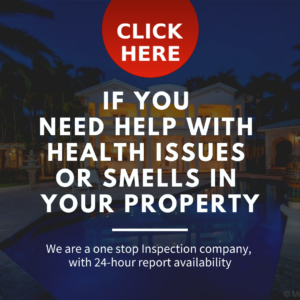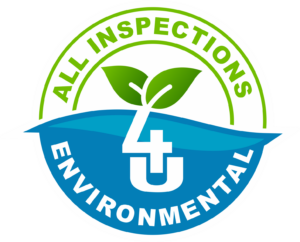Mold Assessments

AVAILABLE SERVICE IN MIAMI, BROWARD & PALM BEACH COUNTIES
One of the most dangerous organisms that can invade your property and it is part of the natural environment, is mold. It is in plants, foods, and organic materials indoors and outdoors. Mold spores can enter your home through windows and doorways and through the heating and air-conditioning systems. Mold thrives in humid environments such as leaky pipes and roofs, bathtubs and sinks, and humidifiers as well. Mold presence can drastically lower the value of your home as well as trigger health problems. Florida is known for its climate and this makes it a perfect breeding ground for mold growth. In most of the cases, the cause of mold issues is because of water intrusion that needs to be identified and corrected to eliminate condition and mold.
Mold, in most of the cases, cannot be identified by visual evidence only and in properties environments will have little to no detection. Everyone reacts differently to the presence of mold, so it’s extremely important to test and find the cause of the mold growth in a property, even if you could not see it. Young children, elderly, people who suffer from respiratory or immune systems and even our pets are the most susceptible for these symptoms. Changes in health conditions could be caused by areas of concern that could be creating the proper environment for mold spores to burst and grow. The color of the mold does not determine how it would affect the human being, since it’s known that everybody reacts different to the presence of mold and if the conditions spread throughout the property it could turn into high concentrations and create mold poisoning even on healthy individuals. Exposure to mold spores can result in nausea, vomiting, headaches and even bleeding in the lungs and nose.
All Inspections 4U will examine all areas that may harbor mold, any areas of concern and collect air or surface samples to determine mold levels. You will be given professional procedures and protocols to correct and eliminate issues present with the mold.
What is involved in a mold assessment?
1. A mold assessment consists of a visual inspection of the conditions of the property at the time of inspection; to include any areas of concern provided by the customer. The areas could be ceilings, windows, plumbing areas, ac system areas and any others where possible water intrusion could be present.
2. Quantitative & qualitative investigation will be performed at the time of inspection to provide accurate reports.
3. Although samples are not required to do an assessment, it will vary in what the customer wants or needs. In most of the cases samples are collected in order to determine types of mold present and if the levels are elevated or not in comparison to the exterior condition of the property.
4. If samples are collected, the mold assessor will determine the best locations for the test and/or if it’s by the customer request. An exterior sample will be collected for comparison reasons. The only case that an exterior sample might not be collected is if the property is by the sea. All our samples collected are analyzed by third party licensed, certified and accredited laboratories with the most up-to-date equipment in the industry.
5. Temperature readings, humidity readings and thermal scanning is done in order to locate sources and areas of concern that could create mold conditions.
6. Equipment used is based on needs basis, but normally it’s a combination of moisture meters, thermal cameras, telescopic cameras, temperature and humidity equipment and air collector pumps.
7. The assessment is presented in a colored report with findings and recommendations with pictures to back up the findings. The reports are presented in 24 hours from the inspection in most of the cases and based on the size of property.
8. A protocol and recommendations are provided on an individual basis and on a case-to-case property needs.
9. In all the cases we try to identify the source and even provide other recommendations based on findings.
10. A mold assessment cost is based on a square footage basis, needs, type of property and condition of property.
A Guide to Mold Assessments & Mold Reports
 Mold exists almost everywhere. There are estimated to be tens of thousands of different types of mold in nature, and several hundred different species can be found indoors. In fact, it is very likely that you have microscopic mold spores in your hair and on your clothing right now. We breathe mold, we eat mold, and most of us go about our day none the wiser. That is because mold only becomes a problem when mold colonization goes unchecked and begins to wreak havoc on a structure and/or human health.
Mold exists almost everywhere. There are estimated to be tens of thousands of different types of mold in nature, and several hundred different species can be found indoors. In fact, it is very likely that you have microscopic mold spores in your hair and on your clothing right now. We breathe mold, we eat mold, and most of us go about our day none the wiser. That is because mold only becomes a problem when mold colonization goes unchecked and begins to wreak havoc on a structure and/or human health.
When mold growth is first discovered, people will usually try to clean it themselves or paint over it, only to find that the mold keeps growing back. This could go on for months or even years, because what they have failed to realize is, if you don’t fix the moisture problem, the mold will always grow back. Some molds can be particularly dangerous to humans, so it is recommended that folks call a professional to help with a mold problem that won’t seem to go away. The most effective way to control mold growth is to control moisture. The EPA link below provides information about mold and moisture for homes, schools, multifamily and commercial buildings. Molds can have a big impact on indoor air quality.
 The Professional Mold Assessment: What to Know
The Professional Mold Assessment: What to Know
Before getting started on a mold investigation, it is very important for the Indoor Environmental Professional (IEP) to understand the concerns and the goal of the client. Most certified mold professionals will start a project with thorough information gathering, client interviews, noting any health concerns, when and where symptoms are worse/better, building history, past water events, areas of concern, etc. A professional mold investigator with field experience will know what questions to ask, what to look for, and how to get to the bottom of almost any mold problem.
After the interview process, the next step is to perform a “walk through” of the building. The IEP will perform a physical inspection, while taking notes, photographs, and measurements. Assessing the location(s) of concern is only part of the process however. The IEP is always looking for both visible and hidden clues, noting leaks, structural issues, visible moisture, water stains, odors, etc. Depending on the project, he or she may also inspect the basement, attic and HVAC system, as those are common sources of mold colonization. After thoroughly inspecting the various areas and issues indoors, the IEP will then head outside to take note of the land slope, roof issues, standing water, exterior mold growth, etc. All of these things can affect if, where, and how mold grows.
The IEP will take indicator measurements during the investigation, such as moisture and humidity levels, size and distance of contaminated or wet materials, etc. Mold samples are only collected if deemed necessary for a particular project, and the reasons for this will vary (discerning types of mold growing, discerning IF mold is growing, hidden mold, client request, etc.) If mold samples are collected, any of the following method(s) may be used: tape lift, dust wipe, bulk sampling, and/or air sampling. The samples are labeled and brought to the laboratory for analysis. Generally, the lab report will show genus (type) and spores per cubic meter for air samples, and genus (not concentration) for bulk and surface samples.
Deciphering the Mold Report
When the investigation and lab analysis are both complete, the indoor environmental professional will then compile a thorough report. The final mold report should include a detailed summary of the project, the findings of the mold investigation, the lab report (if samples were taken), and the IEP’s professional conclusions and recommendations.
Indoor Air Quality (IAQ) reports usually follow an outline similar to the following:
- Introduction
- Observations
- Indicator measurements
- Sampling
- Conclusions & Recommendations
An assessment report document done professionally and thoroughly outlines the details of the mold investigation, explaining the visual observations, scientific data, conclusions and recommendations for this particular project.
Sections I, II, & III of this mold report provide an overview of the job, the building and work plan. In section IV. Findings, the IEP describes what was observed during the physical inspection, and informs the customer about the role of moisture in mold growth. A certified mold professional has vast experience determining the various ways that water and moisture can enter a building envelope and in this particular case, it seems that there were issues with the shower and improper drainage. Information about measurements and mold sampling are also described in this section, as well as some helpful “Mold Prevention Tips.”
Resolving moisture issues is the key to nearly every chronic mold problem, and the IEP should always include this information in their mold remediation (clean up) protocol. The remediation recommendations should be detailed and organized by the various areas of concern (in this case, the bathroom, the basement, AND the attic all have issues needing attention). It is then up to the client to find a reputable company to perform the remediation as outlined in the report. It is well known within the mold industry that it is a conflict of interest to do both the mold investigation and the mold remediation on a particular job, and the public should avoid working with a company who offers to do this. If the company is certified and offers both investigation and remediation services, you might want to contact their certifying body to file a report or get clarification.
Since mold is not regulated like most environmental contaminants, such as asbestos or lead, the IEP cannot make any determinations regarding “safe exposure limits” of mold, but will provide guidance and detailed recommendations for proper remediation procedure. Additionally, although an IEP will have vast experience speaking with clients about their health complaints, they are not medical doctors, and therefore cannot diagnose a client’s symptoms or verify whether or not mold is causing their health problems. The most you can expect from a properly trained IEP is their opinion about whether or not the mold spore counts are higher than normal or whether or not a particular mold species could be considered unsafe (such as stachybotrys, otherwise known as “black mold.”) If your mold contractor gives you medical advice, this should be another red flag.
Once the remediation is complete, we suggest scheduling a “Post Remediation Verification” or “Clearance Report” with the IEP who did the original inspection. It is important to get verification that the mold remediation was performed professionally, accurately, thoroughly and according to protocol. In a clearance, the IEP will re-inspect all areas of concern with a visual inspection, and will take additional lab samples if needed or requested. The Post Remediation Verification is the final step in a mold investigation, giving the client assurance that the mold issue was handled professionally and properly as outlined in the original mold report.
If you hired someone to help with a mold issue and they either didn’t provide a mold report, or the one they gave you doesn’t resemble the one in level of detail and length, then unfortunately you may be addressing your mold issues again in the future. Poorly managed IAQ projects could very well increase the costs and the health risks of a client. To be effective, mold investigations and mold remediation jobs require the expertise of properly trained individuals. Before hiring anyone to help with your mold issues, it is best to remember that old saying, “Buyer Beware,” and be an informed consumer. The mold industry is largely unregulated, quite complex, and sometimes controversial. Hiring a certified professional and knowing the Indoor Air Quality (IAQ) laws in your state is a good place to start.
4U more information
MOLD INSPECTION NEEDS & SERVICE
To schedule an inspection, call (954) 802-8524
Call (954) 802-8524
SCHEDULE AN INSPECTION TODAY





